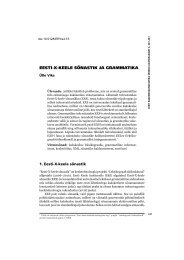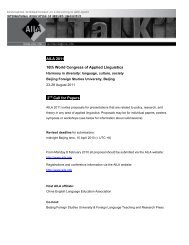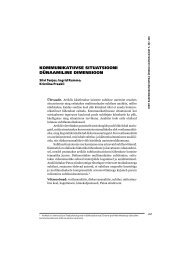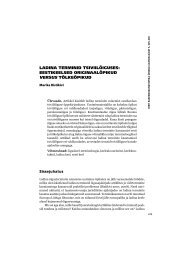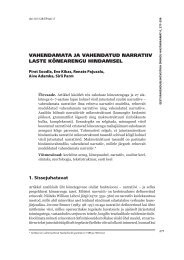ACQUISITION OF CASE IN LITHUANIAN AS L2: ERROR ANALYSIS
ACQUISITION OF CASE IN LITHUANIAN AS L2: ERROR ANALYSIS
ACQUISITION OF CASE IN LITHUANIAN AS L2: ERROR ANALYSIS
Create successful ePaper yourself
Turn your PDF publications into a flip-book with our unique Google optimized e-Paper software.
The locative is not frequently used and has one main function, that is, to express<br />
the meaning of being inside. Other ways of expressing space, location and direction<br />
are prepositional constructions. Examples (40) and (41) show that the students<br />
know the rule for expressing location, when the locative is to be used, but make<br />
errors using this case with prepositions. Examples (40) and (41) are sentences of<br />
Latvian students, thus it can be claimed that these errors are inuenced not by the<br />
students’ native tongue, but by Russian, which is widely spoken in Latvia and has<br />
an impact on Latvian (Dja#kova 2003, Metuzale-Kangere, Ozolins 2005). In the<br />
Russian language prepositional constructions with the locative are used.<br />
3.7. Inappropriate use of declension paradigms<br />
When learning a foreign language, learners often make generalisations of grammar<br />
rules: after having learnt one rule, they apply it to other cases even where it is not<br />
applicable. Such a learning process is positive as it shows the student’s progress.<br />
Students acquire very quickly that in Lithuanian nouns of the masculine gender<br />
mostly end in -as, -is, -us. Later on, according to the overgeneralisation tendency,<br />
students treat all nouns with the ending -s as belonging to the masculine gender.<br />
This is illustrated by Examples (42)$(44).<br />
(42) Po to jis susitiko berniukui su ž"siu: SG:M:<strong>IN</strong>S [= ž#simi: SG:F:<strong>IN</strong>S].<br />
(German)<br />
‘Then he met a boy with a goose’<br />
(43) Aš manau, kad reikia 'statym% leid!jams priimti 'statym# apie euta na -<br />
zij# visuose: PL:M:LOC šaliuose: PL:M:LOC [= visose: PL:F:LOC<br />
šalyse: PL:F:LOC]. (Latvian)<br />
‘I think that all legislators in all countries should pass a law on euthanasia’<br />
(44) Aš negaliu suprasti, kod!l moteriai: PL:M:NOM [= moterys: PL:NOM]<br />
leidžia smurt# šeimoje. (Latvian)<br />
‘I cannot understand why women allow violence in the family’<br />
60<br />
The ndings suggest that students often confuse the types of the paradigms of noun<br />
declension. Students treat these feminine nouns, that belong to a different noun<br />
declension paradigm as masculine ones. Thus they often decline pilis (‘castle’), stotis<br />
(‘station’) and žuvis (‘sh’), which are of feminine gender, as brolis (‘brother’),<br />
which is masculine. The main reason for this type of errors is the unmarked ending<br />
for masculine nouns -is. Students have to remember that there is a certain set of<br />
nouns, which end in -is in the nominative, but in -ies in the genitive, that belong<br />
to a different paradigm and to a different gender, namely, feminine. Examples<br />
(42)$(44) are very typical instances of such an overgeneralisation: the case forms<br />
are correct, but the words ž#sis (‘goose’), šalis (‘country’) and moteris (‘woman’)<br />
are treated according to the paradigm of masculine nouns.<br />
One more reason for making errors related to inappropriate declension paradigms<br />
is students’ reliance on their native tongue. When speaking or writing, <strong>L2</strong><br />
learners often translate from their own native language. If a word in the learner’s



